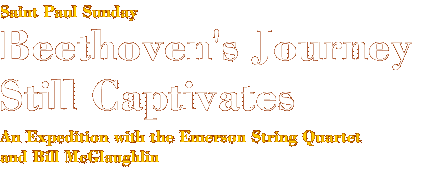


|

|

RealAudio 3.0 28.8 (A RealAudio player is required for listening to the narration and performances on this site. Players are available on the RealAudio site.) Bill McGlaughlin's Narrative Music to Browse by: an Early Quartet
Some very great musicians and thinkers on music have put forth a variety of answers to that question, enough so that I think no one will be offended if I offer another of my own - I think Beethoven's work is so effective because he plays more powerfully than any other composer on the tension that exists in all of us between the intellect and the emotions - the head and the heart.
about life and love and loss and triumph." See Quartets for the Non-Connoisseur This may sound a little abstract, but we find this question all the way back to the dawn of history. The Greeks understood it in terms of two of their gods - Apollo, the sun god and Dionysus, god of the night. It's important that we not see this as a struggle between good and evil, but as a tug of rope between order and freedom. In Beethoven's time, the late eighteenth and early nineteenth century, a great sea change was sweeping Europe, moving from the Age of Enlightenment to that of Romanticism. We see the effects of this change in the revolutions that began to break out, first in America, then in France, running down to the present day. We see this change in literature and painting and we see it with great clarity in music of Beethoven. As he entered the new century, Beethoven was a child of the Enlightenment - a world of light and clarity, honoring intellect and reason and proportion - a time of hierarchy - of princes and order. Against the most unlikely background of the conservative court in Vienna, Beethoven strode off along tangled path of Romanticism, a universe which prized mystery in place of reason, preferred darkness to light, sought extremes of personal sensation and valued above all the passionate utterance of the individual. All men might be brothers, but the artist was prophet. That journey, which Beethoven completed in the quarter century before his death in 1827, still captivates us today. We are drawn by the drama of his fighting alone, rising above the heartbreak of his debilitating deafness, forging a new way. He is the emblem of the Romantic artist, and he makes us his companions on that journey. There is no clearer lens through which to view this journey than through the world of Beethoven's String Quartets. - Bill McGlaughlin
Discover brilliant performances, insightful anecdotes from recording sessions, and revealing commentary throughout the site. Beethoven's Early Period Beethoven's Middle Period Beethoven's Late Period Quartets for the Non-Connoisseur
Saint Paul Sunday is made possible by a major grant from the General Mills Foundation with additional funding from the National Endowment for the Arts. |